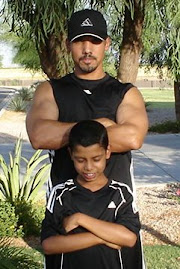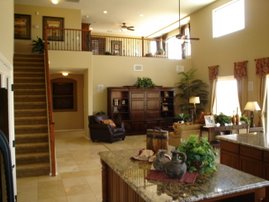Don't believe me? Then you my friend have forgotten your history. From late 1978 through 1986 , mortgage rates were in the double digits. In October of 1981, the average 30 year conventional mortgage rate had reached a whopping 18.45% according to the Board of Governors of the Federal Reserve System.
The Question you may be asking is "Why in the world would interest rates hit 18% again?". That's an easy question to answer. To explain it in a very simplistic manner, it goes a little something like this: When home prices drop, foreclosure rates rise. When foreclosure rates rise, banks lose a lot of money and their stock price gets hammered. When bank stocks get hammered, they can fail (IndyMac for example), get acquired (Countrywide was acquired by Bank of America), or continue with operations with a focus on boosting profits to get back on track. Bank profits come from the interest rates they charge the borrower. Now put yourself in the bank's position...fewer loans are being approved due to tighter lending rules. This means fewer customers to make a profit off of. So how do you increase your profits to make up for the billions lost in the housing bust? You increase the interest rates on the limited supply of borrowers that will qualify for a loan. This equates to higher and higher mortgage interest rates with each year to come. 18% interest rates on conventional mortgages a reality? Ohhh yes! It's coming and faster than you might think.
The Prime rate on December 19, 1980 was 21.50%. According to the Wall Street Journal, the "Prime Rate"can be defined as "the base rate on corporate loans posted by at least 75% of the nation's 30 largest banks". Still think this is a far fetched idea of mine? History doesn't lie. It is what it is and I can tell you we're in for a major interest rate explosion.
The question real estate investors should ask is, "Do I buy now when rates are in the low 6% range or do I wait a little longer for a better purchase price and risk a higher interest rate?". That will be the mantra heard throughout investor circles all over the country.
Just my 2 cents: Buy now and don't wait for interest rates to hit astronomical levels. Prices are incredible right now and with current rates in the 6% range, you'd be crazy not to rap up your last few investments before the tide turns.
Saturday, July 19, 2008
Tuesday, July 15, 2008
Investing And Failing Banks Don't Mix Well
IndyMac Bancorp was seized by the Office Of Thrift Supervision and taken over by the FDIC on Friday. This is one of the largest bank failures in U.S. history. There are at least 300 other banks that may suffer the same fate due to liquidity concerns and mounting foreclosures. Depositors are insured up to $100,000 by the FDIC, but for those with accounts over $100,000 it's bad times.
When banks fail, heightened lending restrictions from other banks tend to follow. These restrictions can have a devastating effect on Real Estate investors looking to borrow money. Fewer lending options are in the near term future as banks tighten up their lending practices. The days of exotic mortgages are over. The same can be said for stated income and negative amortization loans. I mentioned in a prior post that cash is king because cash investors don't have to worry about banks to fund their investments. With the current sign of the times, this could not be more true.
Property values are very attractive nowadays, but getting a loan is about to get really ugly as the potential for more bank failures exist. My advice to those of you interested in getting an investment loan is to get pre-approved as quickly as possible. Underwriting terms are about to change dramatically and current loan products may not be available in the coming months.
When banks fail, heightened lending restrictions from other banks tend to follow. These restrictions can have a devastating effect on Real Estate investors looking to borrow money. Fewer lending options are in the near term future as banks tighten up their lending practices. The days of exotic mortgages are over. The same can be said for stated income and negative amortization loans. I mentioned in a prior post that cash is king because cash investors don't have to worry about banks to fund their investments. With the current sign of the times, this could not be more true.
Property values are very attractive nowadays, but getting a loan is about to get really ugly as the potential for more bank failures exist. My advice to those of you interested in getting an investment loan is to get pre-approved as quickly as possible. Underwriting terms are about to change dramatically and current loan products may not be available in the coming months.
Labels:
exotic mortgage,
failing banks,
stated income loans
Tuesday, July 8, 2008
My Blog's 1 Year Anniversary
Today marks the 1 year anniversary of my Blog site. There have been 2,000 views of the site over the last 12 months. That's an amazing number of views considering it has all been word of mouth with no advertising.
To be honest with you, I wasn't sure I would be blogging beyond a month or two let alone a year. It is far more time consuming than I thought, and it doesn't help that I still type using only 2 of my fingers. Don't laugh, I'm probably the fastest 2 finger typer you'll ever know.
I plan to continue blogging in hopes that I can still offer a little insight for those looking to invest in real estate. Times are challenging now, but this is the time to take advantage of some of the best values in years.
To be honest with you, I wasn't sure I would be blogging beyond a month or two let alone a year. It is far more time consuming than I thought, and it doesn't help that I still type using only 2 of my fingers. Don't laugh, I'm probably the fastest 2 finger typer you'll ever know.
I plan to continue blogging in hopes that I can still offer a little insight for those looking to invest in real estate. Times are challenging now, but this is the time to take advantage of some of the best values in years.
Saturday, July 5, 2008
Real Estate Cycle Trends Can Be Your Friend.
I've researched Real Estate cycles, trends, and related data for a number of years. It's fascinating to uncover the anatomy of real estate and expose what makes it tick. While doing a little research on trends, I found some interesting figures on median prices. In the United States, the median price of a home based on year was as follows: In 1960 $15,000; 1979- $50,000; 1987- $75,000; 1997- $100,000; 2000- $125,000; 2002- $150,000; 2004- $175,000; 2005- $200,000, and in 2006- $230,000. It is clear to see that real estate has been a great investment over the years, but down cycles do exist within the matrix of the ever growing up-side trend.
Throughout the course of history, there have been real estate corrections which have given back a portion of the gains made with each and every appreciation cycle. The long term trend however is always to the up side. These up and down cycles are very predictable because history details this predictability. Unfortunately, if you don't know your history, you may find yourself trapped in a cycle that can destroy a portion of your net worth.
The typical real estate cycle ratio is 5:2. This means for every 5 years of appreciation, we have 2 following years of correction. This is a very healthy part of the real estate cycle because it helps to prolong the affordability of homes. If homes only went up in value, the average person would not be able to afford the cost of homeownership. This correction also allows incomes to "catch up" with the cost of inflation thus allowing more potential homeowners to participate in the home buying process.
The most recent appreciation or "up" cycle was extremely stretched out. It technically started near the end of 1996 and terminated in late 2005 early 2006. This 10 year "up" cycle doubled the norm. One of the reasons for this record setting appreciation cycle was Interest rates. Interest rates were at 45 year lows thanks to the then Fed. Chairman Allan Greenspan who managed to keep the federal fund rate at 1%. Speculators also drove up prices resulting in multiple offers and lotteries. But what goes up does come down, and the ever growing bubble was destined to pop. By late 2005 early 2006 the signs of a correction were underway, and we have since been experiencing that which is known as a down cycle. Because we had an overextended appreciation cycle, the correction will be proportionate. This cycle if played right can be the buying opportunity of a decade because the homes are selling at 20% to 30% discounts compared to just 12 months ago. By buying in corrections, you stand to benefit from the future continuation of the median home price trend.
Throughout the course of history, there have been real estate corrections which have given back a portion of the gains made with each and every appreciation cycle. The long term trend however is always to the up side. These up and down cycles are very predictable because history details this predictability. Unfortunately, if you don't know your history, you may find yourself trapped in a cycle that can destroy a portion of your net worth.
The typical real estate cycle ratio is 5:2. This means for every 5 years of appreciation, we have 2 following years of correction. This is a very healthy part of the real estate cycle because it helps to prolong the affordability of homes. If homes only went up in value, the average person would not be able to afford the cost of homeownership. This correction also allows incomes to "catch up" with the cost of inflation thus allowing more potential homeowners to participate in the home buying process.
The most recent appreciation or "up" cycle was extremely stretched out. It technically started near the end of 1996 and terminated in late 2005 early 2006. This 10 year "up" cycle doubled the norm. One of the reasons for this record setting appreciation cycle was Interest rates. Interest rates were at 45 year lows thanks to the then Fed. Chairman Allan Greenspan who managed to keep the federal fund rate at 1%. Speculators also drove up prices resulting in multiple offers and lotteries. But what goes up does come down, and the ever growing bubble was destined to pop. By late 2005 early 2006 the signs of a correction were underway, and we have since been experiencing that which is known as a down cycle. Because we had an overextended appreciation cycle, the correction will be proportionate. This cycle if played right can be the buying opportunity of a decade because the homes are selling at 20% to 30% discounts compared to just 12 months ago. By buying in corrections, you stand to benefit from the future continuation of the median home price trend.
Subscribe to:
Posts (Atom)

